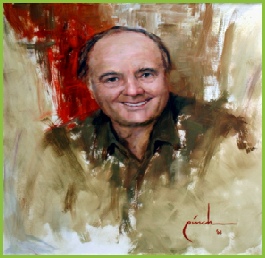
Robert Trent Jones, Sr. (June 20, 1906 – June 14, 2000) was a golf course architect who designed (or re-designed) about 500 golf courses in at least 40 US states and 35 other countries all around the world. It has been jokingly said that, "The sun never sets on a Robert Trent Jones golf course."
He is sometimes confused with the famous amateur golfer and Grand Slam winner, Bobby Jones, with whom he worked from time to time.
Biography
Born in Ince-in-Makerfield, England, Robert Trent Jones accompanied his parents to the United States at the age of five. The family settled in East Rochester, New York where young Robert took a job becoming the first golf professional at Sodus Bay Heights Golf Club which is located in the Sodus Point, NY area. He became an avid and skilled golfer as a youth, but health problems prevented him from joining tournament competition.
Jones attended Cornell University, where he designed his own course of study to become a professional golf course designer, taking courses in landscape architecture, agronomy, horticulture, hydraulics, surveying, public speaking, and economics. During his studies at Cornell, he designed the back nine of Cornell's Robert Trent Jones Golf Course. The course was not used until 1941. Jones later returned in 1954 to complete the front nine. At Cornell, he was a member of Delta Kappa Epsilon fraternity.
The golf course at Green Lakes State Park in upstate New York was designed by Robert Trent Jones and opened in 1936.
After receiving his college degree, Jones formed a partnership with Canadian architect Stanley Thompson, and helped design several courses in Canada, including Capilano in Vancouver and Banff in the Canadian Rockies. In the late 1930’s he struck out on his own and began designing and building local golf courses in America. Many of these, such as the 1936 course at Green Lakes State Park, were built using labor provided by the Works Progress Administration.
Shortly after World War II, Jones got his first big assignment designing the Peachtree Golf Club in Atlanta in collaboration with golf legend Bobby Jones. Despite the similarity of their names, the two men were not related. In fact Robert began using the middle name "Trent" shortly afterward to avoid confusion.
Jones' courses are noted for their artistic landscaping, innovative use of bunkers, liberal use of water hazards, and deft placement of greens and hazards that encourage a high level of strategy. He believed that golf should be a no risk; no reward sport and his designs encouraged daring play.
Jones continued working well past usual retirement age, often working on several courses at the same time. Following a period of failing health, he retired to his home in Fort Lauderdale, Florida. He died there peacefully just a few days short of his 94th birthday. His sons Rees Jones and Robert Trent "Bobby" Jones, Jr., have followed in his footsteps and are now course designers. He sometimes collaborated with his sons. For example, his last design, The Marshes in Ottawa, Canada, is a collaboration with Robert Trent Jones, Jr. and was finished after his death in 2000.
Jones received the 1987 Old Tom Morris Award from the Golf Course Superintendents Association of America, GCSAA's highest honor. He was also inducted into the World Golf Hall of Fame in 1987 as well.

